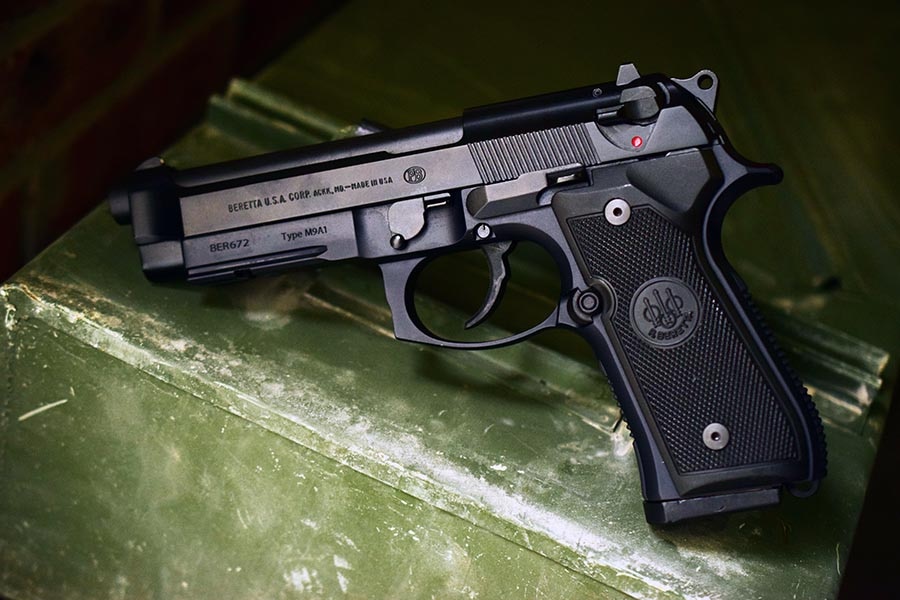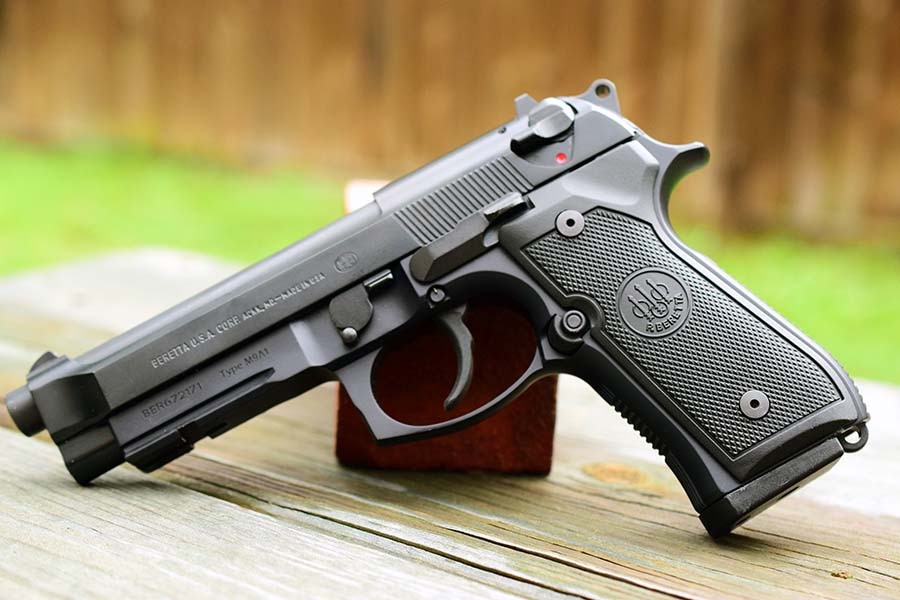When selected in 1979 to replace the M1911 as the standard sidearm of the U.S. military, the Beretta Model 92 faced stiff resistance from troops and civilians alike due to the 9mm cartridge’s purported lack of stopping-power. Once in service the M92, then dubbed the M9, suffered catastrophic slide failures, giving critics further cause for concern. People later discovered that the United States military used 9mm ammo loaded well beyond NATO specs, thus causing the failures, but the damage had already been done. It took years for people to begin to trust the improved M9 with its reinforced slide, when the M9 suffered another blow. Around 2007, M9s in Iraq started jamming left and right and no one had an explanation.

My favorite improvement to the M9 is the addition of a railed dust cover which make the pistol more versatile (Photo by Jim Grant)
After months of testing, an investigative committee determined that the magazines the U.S. military outsourced and tweaked by applying a phosphate finish, were to blame. The thin layer of phosphate reduced the magazine’s internal tolerances to the point that the fine desert sand would cause the follower to bind in the magazine body and prevent rounds from chambering. The malfunctions vanished when a new vendor took the contract, fixed the magazine redesign and began constructing them to Beretta’s original design. Proving that the M92 and its magazines, as they were originally designed, worked fine. Unfortunately, people always remember the plague but not the cure, even if the magazine redesign is the best yet. In fact, some 900,000 units have shipped since then without an issue.

The Beretta-made replacement magazines solved the previous mag-related malfunctions, hold 15 rounds and resist corrosion (Photo by Jim Grant)
With all of the mechanical flaws fixed, the one remaining gripe against the military’s adoption of the M9 was the difference in stopping power between the .45 ACP cartridge of the 1911 and the 9x19mm of the M9. In modern conflicts where the Hague Convention restricts use of expanding bullets, bigger is normally better, especially when it comes to handgun cartridges. Thankfully for most American citizens, access to hollow-point defensive ammunition is only restricted by their bank accounts. With modern expanding ammunition 9mm ammo is on par or better than .45ACP ball without the recoil and limited capacity associated with it.
Just as some returning vets from WWII and Korea longed for their trusty Garand rifles, some of those returning from the War on Terror longed to get their hands on civilian-legal AR15 rifles. Then, not unlike the M1911 that came before it, despite the M9’s lack of military popularity, soldiers started buying the commercial variant, the Model 92FS.
Seeing an unexplored portion of the market, Beretta decided to bring the military-spec M9 to the civilian world. Since they were no longer bound by military contracts to produce the M9 the way it was issued, they improved the design by adding a railed dust cover for accessories and replaced the plastic guide rod with a steel one. The engineers also decided to include a corrosion-resistant finish on the M9A1’s magazines using a proprietary nitride finish, which is thinner than phosphate, to avoid the jamming issues the U.S. military encountered. They dubbed this improved M9, the M9A1, sticking to conventional military naming conventions.
In my experience the M9A1 is enjoyable to shoot. It fits my small hands better than I had imagined, and the all-metal construction soaks up recoil well. The double-action is certainly heavy, but even and smooth. Where the M9A1 shines is with its single-action trigger; it’s perfectly light with little over-travel.
The sights are somewhat small by comparison to modern combat irons, but are functional and are tantamount with standard offerings from Glock and SIG. The nitride-coated magazines hold 15 rounds, and the M9A1 ships with two of them. If a shooter is looking for additional magazines they’ll be happy to learn that the M9A1 takes all standard M92 magazines. Meaning, shooters living in ban-states should be able to find some pre-ban high-capacity magazines fairly easy.
The Beretta’s exposed barrel design, similar to the Walther P38, allows the weapon to cool faster than pistols with a full-sized slide. However, this also means that the exposed barrel, after rapid or extended firing sessions, can burn an unwitting user. Nevertheless, the M9 pistol’s non-tilting, locking-block operating method creates a more accurate pistol and a better suppressor host, because the barrel moves less.
As far as unquantifiable aspects of the M9A1, the balance and pointability are excellent for shooters with medium to large hands and anyone accustomed to firing a Glock. Though the location of the safety/decocker is difficult to hit with the firing hand, with practice becomes second nature.
The M92 series of pistols, M9A1 included, are easy-shooting, accurate handguns that an owner can trust by their bedside. The controls will be familiar to anyone who qualified with an M9 and the ambidextrous safety and short, light trigger makes it suitable for many shooters. The M9A1 is a good-looking pistol and with an MSRP of $750, it ought to be. Many shooters, myself included, still lament the M9’s adoption, but we would be hard-pressed to argue that it hasn’t evolved into a solid combat handgun.
The post Gun Review: The Beretta M9A1 defies its critics (VIDEO) appeared first on Guns.com.




